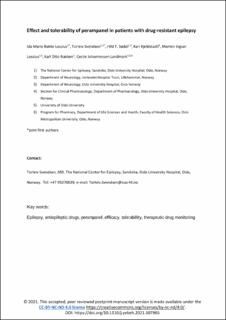Effect and tolerability of perampanel in patients with drug-resistant epilepsy
Lossius, Ida Marie Bakke; Svendsen, Torleiv; Sødal, Hild Flatmark; Kjeldstadli, Kari Grandaunet; Lossius, Morten Ingvar; Nakken, Karl Otto; Landmark, Cecilie Johannessen
Peer reviewed, Journal article
Accepted version
Permanent lenke
https://hdl.handle.net/11250/2984059Utgivelsesdato
2021-04-30Metadata
Vis full innførselSamlinger
Sammendrag
Objective: Perampanel is one of the most recently approved antiseizure medications. The aim of the present study was to assess clinical efficacy and tolerability, in combination with pharmacokinetic variability, of perampanel treatment in patients at a tertial referral center for epilepsy.
Methods: We performed a retrospective observational study of patients given perampanel as adjunctive treatment in the period January 2013 - February 2019 at the National Center for Epilepsy at Oslo University Hospital, Norway.
Results: Clinical data were available for 175 mainly adult patients with drug-resistant epilepsy with mean treatment duration of 16.1 months. We found that 23% (40 patients) were responders (i.e., achieving more than 50% reduction in seizure frequency), four of whom became seizure free, 29% (51 patients) experienced a modest effect, whereas for 29% (50 patients) perampanel had no seizure-reducing effect. A paradoxical effect, with seizure aggravation, was reported in 9% (15 patients). The responder rate was significantly higher in those with slow vs. fast dosage titration. Logistic regression analysis showed better efficacy among those with generalized vs. those with focal epilepsy. Adverse effects were reported by 135 patients (77%), ranging from mild (34%), to moderate (41%) and severe (2%). In 55 patients (41%), these adverse effects resulted in discontinuation of treatment with perampanel. The most frequent adverse effects were psychiatric symptoms (34%), dizziness (31%), and sleepiness (26%). Of the 31 patients for whom serum concentration measurements were available, the mean daily perampanel dose was 6.3 mg (SD 3.0), with a mean serum concentration at steady state of 1.03 μmol/L (range: 0.15-3.59 μmol/L). There were pronounced differences between patients, as demonstrated by a 12-fold variability in the range of concentration/dose (C/D)-ratios (0.06 to 0.69 μmol/L/mg).
Conclusion: Our results demonstrate that perampanel had a modest seizure-reducing effect in this very treatment-resistant patient group. Predictors of treatment success were generalized epilepsy and slow dosage titration. In patients without a history of psychiatric problems, clinicians could consider increasing dose of perampanel beyond 6 mg daily, taking co-medication and serum concentrations into account.

